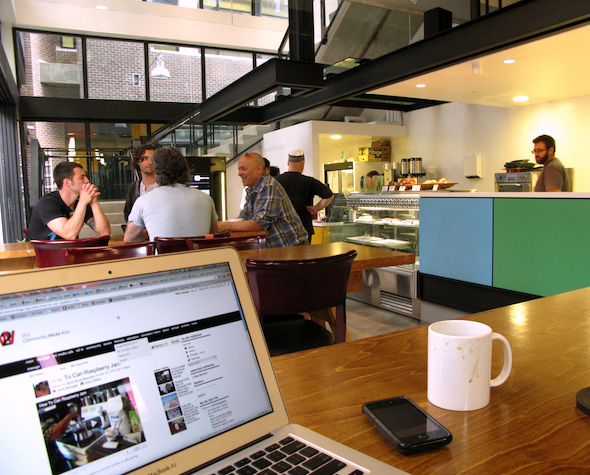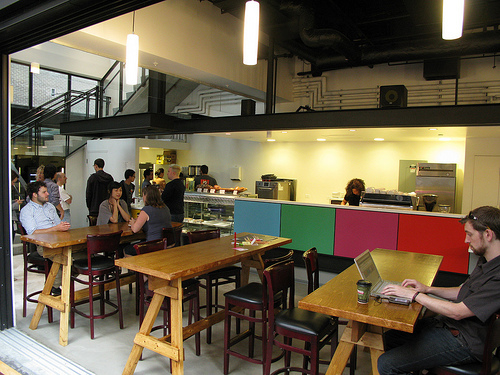The challenges faced by this strong, tight-knit community aren’t simple or easy to resolve. More than 200 NGOs operate here, and countless social workers, law enforcement professionals, health professionals, and city planners have so far failed to make it a truly safe neighbourhood.
W2 Media Cafe
W2 Media Cafe
The W2 Centre aims to contribute to the solution. Unlike most NGOs, though, it doesn’t plan to foist its programs on the ‘hood. Executive Director Irwin Oostindie and his team don’t claim to have the answers. Instead, the community will program the centre. Interested in learning photography? Great. Bring some friends together, W2 will help find a local teacher, and you can host a course. Chinese poetry? Great. Let’s find an elder in nearby Chinatown who can share her knowledge. It’s up to the neighbourhood, not some imported “expert.”
W2 will also operate an incubator for micro social enterprises, a printing facility for public use, a significant convening space for meetings, conferences and other events, and more. And it’s all fronted by the W2 Media Café, which acts as a symbolic welcome mat for the community.
W2 Media Cafe Inside Seating
W2 Media Cafe
The great inspiration behind W2 is the simple recognition that the answers to the challenges of the Downtown Eastside won’t be simple. But then, neither are most answers sought by social entrepreneurs. That’s because the problems we face aren’t simple either.
Defining the challenges we aim to meet
Simple problems are like baking a cake; you just have to read the instructions! Cause and effect are obvious. “Best practices” exist, and we can train others to repeat the solution. (It’s written on the side of the box!)
Other problems are complicated, like flying to the moon. Cause and effect can be discerned, but it takes deeper analysis and more expertise. We can see a problem, analyze it, and respond accordingly. Only good practices can be defined, because the subtleties are significant. In social enterprise, we face complicated problems every day. We learn on the job. We develop systems and processes to smooth the way forward, on strategy, on budget, and on mission.
Then there are the complex problems. Cause and effect are clear only in retrospect. We must analyze the problem first, then seek solutions that emerge from our analysis. Complex problems are like raising a child: Do everything right, do your best every day, and your child may grow up to be a Nobel Laureate. Or they might equally end up a convicted criminal.
The fourth and final category is chaotic problems, where a relationship between cause and effect simply doesn’t exist at a systems level. The hours after a major disaster—such as the Banda Aceh tsunami of 2004—are chaotic. Expert agencies like Red Cross must simply react as best they can, and adapt quickly. (There’s no time to strategize a social enterprise response here!)
This typography of problems is known as the Cynefin Framework. It’s a useful way of identifying the types of problems we face, and defining the right ways to respond.
| The Cynefin Framework | ||
| Problem Type | Identifying Factors | The Approach to Solutions |
| Simple | Relationship between cause and effect is patently obvious | Sense the problem, categorize it, and respond using best practices |
| Complicated | Relationship between cause and effect requires analysis | Sense the problem, analyze it, and respond using good practices |
| Complex | Relationship between cause and effect can only be identified in hindsight | Probe for understanding, sense the problem, and respond using emergent practices |
| Chaotic | Relationship between cause and effect doesn’t exist at a systems level | Act first, sense the impact, and respond using novel practices |
Equipping ourselves to face complex problems
As social entrepreneurs, we face complex problems head on: urban degradation and decay, and the social issues these trends bring with them; the accelerating march of climate change, and the diverse consequences on ecosystems, animal populations and human cultures; international conflict, and the unimaginably harsh capacity of “security forces” to mete out pain on their fellow citizens.
While social enterprise cannot be the solution to every problem, it can and does provide opportunities and answers for some aspects of these significant challenges.
Leading a social enterprise that aims to resolve these “complex” problems is no small feat. The strategic thinking, diverse skills and capacity, and enduring resilience of successful social entrepreneurs are characteristics that should be the envy of most leaders of traditional business. These inspiring leaders engage their colleagues, develop enduring coalitions, and effect the systemic change necessary to redress societies’ hardships and failings.
So how can we, as dedicated social entrepreneurs, learn to lead with this capacity? How can we imitate the great leaders of history—Gandhi, Kennedy, Dr. King, just to name a few from the last century?
Leadership: Self-awareness, self-management and self-development
Leadership begins with self-awareness. When we contemplate great leaders (whether huge names, or those closer to home) patterns of behaviour and capacity are clear. Effective leadership always begins with deep self-reflection. Self-aware leaders understand where they are strong, and where they need the support of those around them to mitigate their weaknesses. They recognize and articulate their own assumptions, and the impact they might have on their decision-making. And they’re clear on the values and limitations that influence their intent and their actions.
There are three easy and sure routes to self-awareness:
- First, take regular breaks from your work. We all know the invaluable perspective that comes from time away. It enables us to see the trees and the forest. We simply don’t do it often enough. Breaks might be midday meditations, quarterly week-long retreats, or a longer sabbatical. Or all of the above. Time away from our missions refreshes our resolve, renews our capacity, and ultimately deepens our impact.
- Second, form a personal advisory board of trusted friends, colleagues and allies who will lovingly tell you the honest truth, helping you identify, articulate and learn from your mistakes. Meet with them regularly (it doesn’t have to be formal), and especially during challenging times or crises.
- Third, do the inner work it takes to understand how you react when the going gets tough, and to learn your strengths and weaknesses. Knowing yourself is half the battle, but too often we move through life on autopilot. Take a look at InnerActivist.com for ideas and practices you can use.
Successful leaders also manage themselves, taking personal responsibility for their energy, their performance, and their health. They recognize that the height of their ambition will take inimitable energy. They manage themselves, so they have the energy to lead their cause. Complex problems, after all, are resolved through marathons of effort, not sprints.
Self-management begins with self-awareness, but day-to-day, effective time management is profound in its contribution to achievement of results. Countless “systems” exist, and even more products are available. Many people are advocates of GTD—Getting Things Done. Stephen Covey’s The Seven Habits of Highly Effective People remains invaluable decades after its publication. Whatever system you choose, make best use of it and tailor it to your particular role, responsibilities and life.
Impactful leaders also develop themselves with intention and dedication throughout their whole lives. They never stop inquiring, learning, improving and seeking opportunities and challenges to build their own character and grow as human beings and as leaders. They indulge their curiosity; they read voraciously. Like martial arts masters, they train every day, because it is the very act of practice that preserves our ability to learn, to adapt and to remain innovative. After all, “change is the only constant.”
By focusing on self-awareness, self-management and self-development, the leaders we respect by definition demonstrate that for which we respect them—their incredible depth of character, their honesty, their integrity. And their resilience.
The five dimensions of leadership
Of course, character and resilience aren’t sufficient to change the world. Social entrepreneurs’ capacity to lead themselves is but the first of five vital dimensions of social enterprise leadership. The others include the capacity to engage the people around us, the achievement of measurable results, the increasingly essential ability to develop inter-organizational collaborations, and the breadth of view to contemplate the entire system, while also working within it.
The good news is that there are social enterprise leaders working today who embody these skills. Even better, each of these capabilities, and the specific skills within them, can be learned. By focusing on development of effective leaders, we can accelerate the social enterprise movement to achieve its promise of a world made better by the power of business.
Catch up on the rest of Mike’s Leadership Series:
Part 2: Social enterprise leadership: Engaging others
Part 3: Four keys to social enterprise leadership
Part 4: Collaborating across the boundaries of organizations
Part 5: Shifting perspectives and transforming systems
Mike Rowlands leads Junxion Strategy’s Vancouver office and is well known as the “CEO Whisperer.” Specialising in TrustBrand development for social ventures, and outreach and engagement for responsible businesses, Mike works to accelerate the potential of social entrepreneurs and intrapreneurs.




